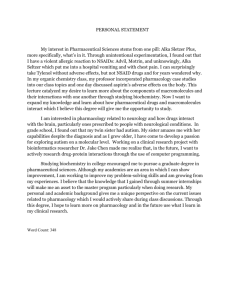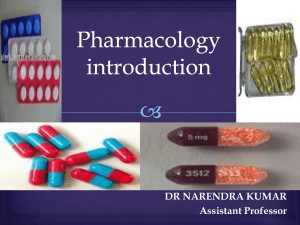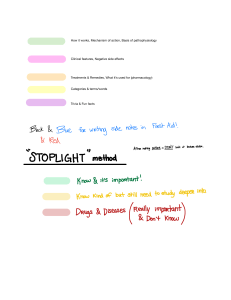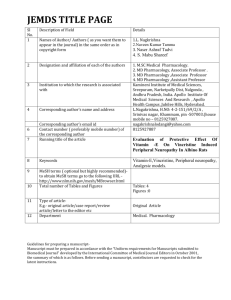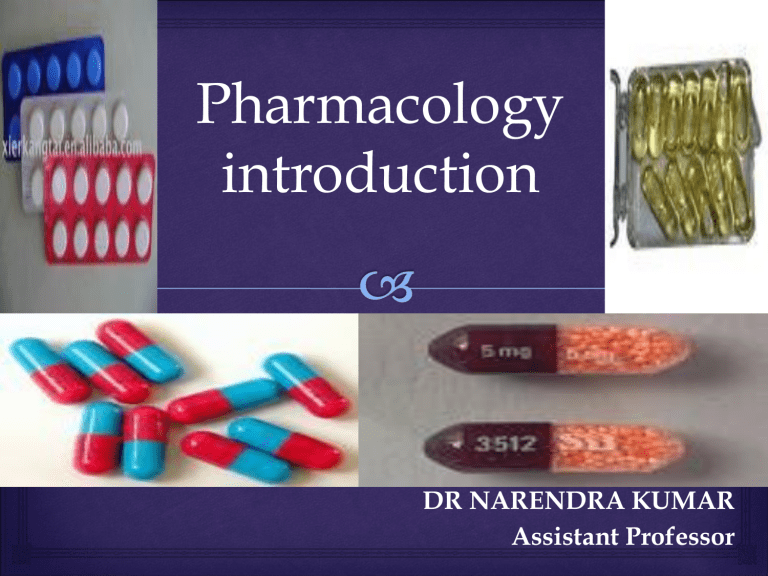
Pharmacology introduction DR NARENDRA KUMAR Assistant Professor Introduction 🙢 Living Organism DRUG Physiology GY O L O C ARMA PHPharmacology Biochemistry 🙢 As per WHO Scientific group “Any Substance or product that is used and intended to be used to modify or explore the physiological system or pathological state for the benefit of the recipient “ Drug categories 🙢 Prescription drugs Are used under only medical supervision and dispensed by an order of medical practitioner only OTC drugs Can be sold over the counter without prescription Sub divisions of Pharmacology 🙢 🙢 🙢 Pharmacopoeias Formulary British pharmacopoeias Pharmaceutical codex(by pharmaceutical Society of Great Britain ) United states Pharmacopoeias National Formulary (by American Pharmaceutical Association) Indian Pharmacopoeias National Formulary of India Non offical Compendia 🙢 🙢 Serves as Secondary Source of drug Information both by Generic name and Trade name 🙢 This Information is generalized and is not restricted to only those drugs which are approved for use by the legally constituted committee of that country . For Example : 1. AMA Drug Evaluation : by American Medical Association and Council on Drugs 2. Modern Drug Encyclopedia: by Yorkee Medical books , New York, USA 3. Physician’s Desk Reference (PDR) : by Medical Economics Publications ,USA 4. Martindale Extra Pharmacopoeias : by Pharmaceutical Society of Great Britain . DRUG NOMENCLATURE 🙢 A drug generally has three categories of names: (a) Chemical name ▪ It describes the substance chemically, e.g. 1-(Isopropylamino )-3-(1-naphthyloxy) propan-2 –ol for propranolol. (b) Non-proprietary / official name / Approved name ▪ Name in the official books accepted all over the world (c) Proprietary (Brand) name ▪ Crocin for Paracetamol 🙢 Essential medicines 🙢 🙢 Essential medicines, as defined by the WHO are "those drugs that satisfy the health care needs of the majority of the population; they should therefore be available at all times in adequate amounts and in appropriate dosage forms, at a price the community can afford." Orphan Drugs 🙢 🙢 These are drugs or biological products for diagnosis/treatment/ prevention of a rare disease or condition, or a more common disease (endemic only in resource poor countries) for which there is no reasonable expectation that the cost of developing and marketing it will be recovered from the sales of that drug. 🙢 e.g. sodium nitrite, fomepizole, liposomal amphotericin B,, rifabutin,, somatropin, digoxin immune Fab (digoxin antibody), liothyronine (T3) and many more. 🙢 Governments in developed countries offer tax benefits and other incentives to pharmaceutical companies for developing and marketing orphan drugs (e.g. Orphan Drug Act in USA). Laws governing Drugs (Drugs Schedule ) AS per detailed in USP Vol.XXII and by NF 🙢 Schedule I Schedule II Schedule III Schedule IV Schedule V 🙢 🙢 Bibliography •Essentials of Medical Pharmacology -7th edition by KD Tripathi •Goodman & Gilman's the Pharmacological Basis of Therapeutics 12th edition by Laurence Brunton (Editor) 🙢 •Lippincott's Illustrated Reviews: Pharmacology - 6th edition by Richard A. Harvey •Basic and Clinical pharmacology 11th edition by Bertram G Katzung •Rang & Dale's Pharmacology -7th edition by Humphrey P. Rang •Clinical Pharmacology 11th edition By Bennett and Brown, Churchill Livingstone •Principles of Pharmacology 2nd edition by HL Sharma and KK Sharma •Review of Pharmacology by Gobind Sparsh

